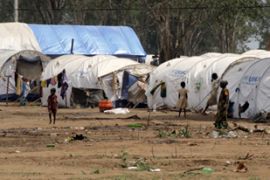Sri Lanka toll ‘may never be known’
Senior UN official rejects report of 20,000 civilian deaths in final days of conflict.

“That figure [20,000] has no status as far as we’re concerned,” Holmes said.
‘Unverified estimates’
Holmes said that the Times figure was based on an unverified and unofficial UN estimate of about 7,000 civilians dying during the end of April, and another 1,000 dying daily after that.
| Focus: Sri Lanka |
  Sri Lanka’s uneasy peace Sri Lanka’s uneasy peace Obituary: Velupillai Prabhakaran Obituary: Velupillai Prabhakaran Q&A: Sri Lanka’s civil war Q&A: Sri Lanka’s civil war The history of the Tamil Tigers The history of the Tamil Tigers Timeline: Conflict in Sri Lanka Timeline: Conflict in Sri Lanka Tamil diaspora sceptical over ‘win’ Tamil diaspora sceptical over ‘win’ Riz Khan: What now for Sri Lanka’s Tamils? Riz Khan: What now for Sri Lanka’s Tamils? Calls mount for inquiry into Sri Lankan conflict Calls mount for inquiry into Sri Lankan conflict |
He said that the initial figure of 7,000 deaths as the military closed in on the LTTE in the country’s northeast was not released by the UN as it was considered too unreliable.
Those were “estimates based on the best evidence that we had, but that wasn’t very good evidence because we weren’t really present in the [battle zone] in any systematic way,” Holmes said.
“That’s why we didn’t publish them.”
Maja Darawala, the director of the Commonwealth Human Rights Initiative, told Al Jazeera: “I realise that people feel from the past behaviour of the Sri Lankan government that they would be reluctant to have this issue examined by an independent panel.
“But I think that for their own credibility and the future of peace in that island they must do it.
“These conjectures will become more and more damaging unless there is a simple way of checking it out. And there are simple ways. The evidence is there.”
During the final months of the war, civilian deaths were thought to have risen sharply. While government troops were accused of shelling civilians trapped in the conflict zone, the separatist Tamil Tiger fighters were suspected of using civilians as human shields.,
Both Colombo and the LTTE rejected the accusations.
UN denial
The government banned journalists and international organisations from the conflict zone as they stepped up operations against the LTTE, meaning that any allegations of atrocities could not be verified.
The UN Human Rights Council decided this week not to investigate the civilian deaths in the war.
Holmes also refuted an assertion in a Times editorial that the UN “had no right to collude in suppressing the appalling evidence” of a massacre undertaken by the government.
“I resent this allegation that we’ve been colluding with the government in some way or not taking sufficient notice,” he said.
“We have been the ones drawing attention to this problem when the media weren’t very interested several months ago.”
The UN estimates that between 80,000 and 100,000 people were killed since the LTTE took up arms in the early 1980s, seeking a separate homeland for ethnic Tamils in the north and east of the island country.
The Tamil Tigers accused the Sinhala-dominated government in Colombo of neglecting the Tamil minority.